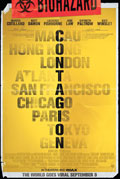Film’s multiple plotlines emphasize infection


Get a facemask and break out the hand sanitizer. This first offering for fall features will make you pause before grabbing a doorknob or shaking someone’s hand.
“Contagion” is the latest global-scale thriller from Warner Bros. and not their first entry into films that follow the events and characters affected by a worldwide pandemic.
A major thing that sets this film apart from movies like “Pandemic” (2009), “Outbreak” (1995), or the Stephen King miniseries “The Stand” (1994) is the structure of the plot.
This plot spreads and grows more complex with every moment in the film. It is as if the plot itself is its own virus.
The major strains of the plot follow three central groups who are affected by the virus in different ways.
The first is the family of Beth Emhoff (Gwyneth Paltrow), an international businesswoman whose death throws up red flags to officials that perhaps other deaths occurring may be related. The struggles her husband, Mitch (Matt Damon) and daughter, Jory (Anna Jacoby-Heron), have with her death and with the world the disease is creating provide the kind of emotional anchor that keeps this film from being a clock-driven body count machine.
The second plot strain follows the experts of the Center for Disease Control and the World Health Organization as they work toward discovering the cause and then perhaps a cure for the disease.
With this thread, Laurence Fishburne takes the skills honed on “CSI” and applies them to the character of Dr. Ellis Cheever, which allows him to make the medical jargon not only believable but also understandable.
The third perhaps lesser strain of the plot follows Alan Krumwiede (Jude Law), a journalist that first breaks the story of the illness and his continuing coverage as the disease spreads. Through him we get to see another thing spread — information.
For reasons that will be left for you to discover, I think this portrayal of the media is a bit unfair, but I don’t hold it against the film makers as there are people very much like Krumwiede in the world.
Technically, this film is a breath of fresh air. Unlike many disaster thrillers, the special effects budget wasn’t spent on things like 400-foot waves, but on making this disease and these people as believable as possible.
Steven Soderbergh, a director who has handled a variety films like “Ocean’s Eleven” (2001) and “Traffic” (2000), brings to this film a unique eye that makes many of the shots in the film unnerving.
Much of the camera work around the sick is so rigidly focused that every pore of those portraying the infected becomes an extra in the shot.
The color palette of the film also places a metallic taste in the mouth by reserving saturation for pre-virus flashbacks and tinting much of the film in sickly hues.
I would recommend seeing it in theaters, if you don’t mind noticing every cough as you sit in a room filled with about 300 strangers.
Rating: A
To contact Michael Wormley, email communitywriter@occc.edu.